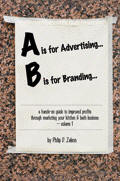|
Developing Your
Database
By Phil Zaleon
Effective marketing requires delivering the right message to the right person
at the right time in the right media.
Imagine your closing ratio if you could mass communicate individually with
each potential client one-on-one. If you knew about their individual needs,
desires, family status, lifestyle and budget, you could target your message to
fit those attributes.
Now, what if you knew why they made the decisions they did…and if you
understood each person’s communication preference? Wouldn’t you use that
information to close the deal?
That is the essence of relationship marketing – it’s the ability to have a
one-on-one conversation with all your past and potential clients simultaneously
– to develop a unique relationship. With today’s technology, kitchen and bath
dealers and designers establish and maintain mass communications tailored to the
individual client across various media simultaneously and continuously.
While there are companies that specialize in database programs geared for the
kitchen and bath industry, dealers and designers can also create these
relationships utilizing basic office technology. It all begins with a database
of information about the clients.
Collecting Data
Long before I knew there was a kitchen and bath industry, I worked in
broadcast television. During that time, I met Gayle, an account manager at a
high-end digital animation studio. During the course of our conversations, she
would ask rather pedestrian questions and then listen carefully – nothing was
too mundane. I later discovered that my responses and comments were transferred
to my “dossier” – an index card. Gayle knew my birthday, my anniversary, my
wife’s birthday, how I drank my coffee and thousands of other preferences. I
would get reminder calls about things I had told her…“Did you buy that gift for
your wife? If not, you’d better get it today.” I had three opportunities to use
a high-end animation studio; Gayle got the job each time.
She was the queen of databases before we had desktop computers. Gayle
understood the concept of relationship marketing and the need to learn about her
clients and prospects in order to be successful.
The first step in developing a relationship marketing program is creating the
database, and the first step in developing a database is to determine the
information you want to capture. Gretchen Cutsler, marketing director of
Beaufort, SC’s Kitchen Design Center says, “We strive to collect complete names,
titles, organizations, addresses, phone numbers, e-mail addresses, Web sites –
if applicable – and comments.”
Michael A. Luzier, CKD, of ML Designs in Aurora, CO, takes his database even
deeper. “Although it varies by client, we try to collect birth dates,
anniversaries, date of purchase for follow up and other pertinent information.”
 Tim Aden, CMKBD, co-owner of Sawhill Custom Kitchens & Designs, Inc. in
Minneapolis states, “In addition to the usual information, we are diligent in
asking people to opt-in to our mailing list for newsletters and other
communication we send.” Tim Aden, CMKBD, co-owner of Sawhill Custom Kitchens & Designs, Inc. in
Minneapolis states, “In addition to the usual information, we are diligent in
asking people to opt-in to our mailing list for newsletters and other
communication we send.”
“If you only collect the ‘usual’ information, you’re barely scratching the
surface of the potential of your list,” says Paul McDonald, president of Royal
Cabinet Co. in Hillsborough, NJ. “We attempt to capture as much information as
possible, for instance when they came in, what products they showed interest in,
hints about how they make decisions, lifestyle information, etc. I have learned
from experience that the more I know, the more effective the follow up.”
Once you begin to collect the information, you need to determine where you
will store the data. There are several great programs you can use, including
Access and Excel FileMaker Pro, Act, Outlook and even some accounting programs.
Generally, software that provides the flexibility to create large numbers of
fields and export information as a tab- or comma-delimited file is sufficient
for basic relationship marketing programs.
In addition to the off-the-shelf products, there are some created exclusively
for the kitchen and bath industry, typically as part of showroom management
programs. For instance, according to Brian O’Rourke, founder and president of
The Kitchen Pond, “We created fully integrated lead tracking and data entry
systems as a part of Kitchen Manager. We found that through forms, design
surveys and day-to-day conversation, kitchen designers learned a lot about their
clients and they needed to be able to track that information – and not just for
marketing purposes, although it certainly works for that. Having information at
your fingertips allows you to react to a client quickly and effectively.
Relationship marketing is a bonus.”
While collecting the information can appear to be a challenge, with a little
creativity, good listening skills and diligence you can create a robust
database.
Cutsler collects information “while I am on sales calls with architects,
interior designers, home builders, real estate agents and other allied
professionals to sell Kitchen Design Center’s services. I take precise notes
during my meetings and transfer the information to our database. In addition, we
gather data from professional Web site directory listings, ads, association
meetings and networking functions.”
Aden says that, “As tenants in Minneapolis’ International Market Square,
Sawhill Custom Kitchens and Designs gets numerous trade and consumer events in
our building, and that’s a lot of traffic. We make every attempt to get these
visitors to complete a guest registration form, on which we ask for the basic
information, including e-mail addresses. We include a check-box on the card that
gives us permission to contact them with e-mails. This is especially important,
as sending non-solicited e-mail needs to be in compliance with U.S.
anti-spamming laws.”
 “Everyday conversations with our clients provide invaluable information for
our database,” adds Luzier. “As we get to know clients, we add pertinent
information to the database; important dates such as birthdays and
anniversaries, favorite restaurants and other lifestyle information that allows
us to communicate and connect more effectively.” “Everyday conversations with our clients provide invaluable information for
our database,” adds Luzier. “As we get to know clients, we add pertinent
information to the database; important dates such as birthdays and
anniversaries, favorite restaurants and other lifestyle information that allows
us to communicate and connect more effectively.”
“If it looks like a source of information or appears to be a way to enhance
your database – it is,” says Gluck. “I look through trade magazines and news
stories; I talk to friends, associates and clients. I am a regular at trade
shows and networking events, and I use our Web site to collect information.”
The Internet offers today’s relationship marketer an effective tool for
gathering information about potential clients. People are looking for
information and Web sites are a great place to offer it. In addition to basic
“brochure” information found on most sites, dealers and designers can offer more
detailed information via Adobe Acrobat files, a blog, a podcast, a video of a
seminar or PowerPoint slides. Then, Web site visitors can be asked to complete a
form to gain access to these “extras.”
As an example, I often offer the handouts from my marketing seminars on our
Web site, but only to those who fill out a form with contact information. Over
the years, my database of kitchen and bath professionals has grown to about 700,
with more joining each week.
Another way to build and enhance a database is to purchase a list of mailing
addresses, occupations or association memberships. It’s a good idea to avoid
purchasing e-mail lists, however, since these can quickly become dated, and can
be problematic to use due to anti-spamming laws.
Mailing lists are available for purchase in almost every configuration
imaginable, with cost being determined by the number of variables requested. In
fact, Aden notes, “We just purchased a mailing list for our semi-annual
newsletter program. We wanted to target a specific suburb of Minneapolis known
for its luxury homes; for less than $500, we got the top 1,600 homeowners in the
area. They will all be receiving our next newsletter.”
McDonald adds, “When purchasing lists, we tend to look at annual income, as
well as home ownership and tax value. The owner of a million-dollar home may be
retired without the disposable income required to fit our target client. With
the ability to slice and dice a list based on specific criteria, we want to
optimize our efforts with the closest match to our ‘target client.’”
In addition, information can also be gathered through give-a-ways at home
shows, or through advertising efforts. One way to do this is to offer a free
incentive to one lucky winner, but to let people know that to be eligible, they
must complete an entry form – which, of course, becomes a part of your
database.
“Over the last few months, we have begun to hold open houses which are a
combination educational seminar and factory tour of our cabinet manufacturing
facility,” says McDonald. “By requiring a pre-registration, we are able to
collect information before anyone ever sets foot in our showroom, and once they
are here and we begin conversations, additional data is added. We also gave away
a free vanity at our initial open house, and asked that an entry form be
completed to become eligible to win.”
Using Your Database
Collecting data and maintaining a central repository gets you started – now
how do you use this information to effectively increase profits?
Remember that your goal is to develop a relationship through personalized
communication based on what you know about your [potential] client. So, in
addition to the “usual information” (name, address, etc), consider the message,
the timing and the delivery system.
Even if your message is generic, whether you send it as a postcard during the
first or second week of the month may impact the response rate. Mail sent the
first week may get lost in a mass of bills, and never see the light of day,
while mail sent during the second week may stand a chance of being read.
What effect would there be if the delivery system was a postcard to one
person and a DVD to another? Would you personally take the time to view a DVD?
Would it intrigue you enough to pop it in the player? It would be great if you
knew enough about your recipients to know what they prefer.
 Many dealers are participating in basic relationship marketing. According to
Aden, “We use ‘mail merge’ to create labels for the Thanksgiving and holiday
cards we send, for post-project surveys and testimonial letters, as well as for
anniversary cards a year after the project is completed.” Many dealers are participating in basic relationship marketing. According to
Aden, “We use ‘mail merge’ to create labels for the Thanksgiving and holiday
cards we send, for post-project surveys and testimonial letters, as well as for
anniversary cards a year after the project is completed.”
At Kitchen Design Center, Cutsler says “We utilize our database for monthly
e-newsletters, and for letters to prospective clients and allied professional
partners.”
“We personalize thank you notes” adds Luzier. “Immediate follow up after a
sale for referrals is proven to generate about a 15% return.”
According to
Gluck, “In addition to newsletters and birthday cards, I send information I
think my clients will find interesting – regardless of industry. If you are in a
position to help inform potential clients with relevant e-mails or articles, you
have accomplished a couple of goals; first, you have developed the relationship
just a bit more, and second, you have made them a more informed purchaser of
your services.”
But this is just the beginning. Consider two communiqués: One is the generic
kind you might send introducing a sale on Brand X dishwashers, while the other
is written utilizing the information you have in your database.
Database information is indicated with << >>.
Dear <>,
When you visited our showroom last <>, you
said that you wanted the <> in
your new <>. And as I recall, you said that were likely to begin
the project around <>. <>, the good news is
<> is giving me a great deal from now until the end of the year.
You can begin 2007 with a new <> and be the envy of your
neighbors on <>! I will call you Thursday evening to
follow up, or call my office to schedule an appointment.
Thanks, and I look
forward to working with you <>.
Or you can send the following:
BRAND X Dishwashers are on sale until the end of the year. Call to make an
appointment with a member of our design team, or come by our showroom. Begin
2007 with a brand new kitchen with the new innovative BRAND X Dishwasher!
Put yourself in the customer’s position – which message influences you
more?
Gluck offers these words of advice: “Use relationship marketing as a general
tool, but make sure the information is accurate before you send information.
Databases are great, but very often, you will still need to pick up the phone
and make contact to maximize your success.”
Cutsler adds, “When prospective clients arrive at your showroom, have a
sign-in sheet or questionnaire to gather e-mail and other contact information
for future communications. Develop a client satisfaction survey.”
“Keep the list up to date. If a message is returned, adjust the database
accordingly,” recommends Aden. “Use calls to action to track the message to help
determine what works best. Collect as much data as you can and use it for a
number of different marketing efforts. And finally, don’t be afraid to spend
some money developing the list, because the more you use it, the more valuable
it becomes. Although it’s time consuming to start from scratch, you’ll be amazed
at how many uses there are for such data.”
Luzier adds, “Any firm that wants to grow should be doing referral follow up.
An accurate and robust database makes it simple, efficient and effective, and it
will pay off – literally. Either launch your own, or retain a professional to
help, but develop a database today.”
Today’s technology gives kitchen and bath dealers and designers the power to
mass communicate with individuals on a personal level, developing and enhancing
relationships resulting in increased sales and higher profits. It all begins
with the database that facilitates the delivery of the right message to the
right person at the right time in the right
media.
********
Philip D. Zaleon is founder and president of Chapel
Hill-based Z promotion & design – a full service
integrated marketing and creative agency focusing on the
kitchen and bath industry.
Prior to founding Z promotion & design in 1996,
Phil held the position of v.p./research &
development for a new technology-based communications
firm.
Phil is currently Vice President
Communications/Technology for the Eastern Carolinas
Chapter of NKBA, an industry speaker on marketing,
advertising and technology subjects and author of "A
is for Advertising... B is for Branding... a hands-on
guide to improved profits through marketing your kitchen
and bath business - volume 1".
Z promotion & design is a member of NKBA and KCMA.
He can be reached at Z promotion & design, P.O.
Box 17291, Chapel Hill, NC 27516; Telephone:
919-932-4600; Fax: 919-932-4447;
E-mail: phil@kitchenmarketing.com
Web site: www.kitchenmarketing.com

|
|
copyright © 2006
All rights reserved Cygnus Interactive,
a Division of Cygnus Business Media.
|
| 



 Tim Aden, CMKBD, co-owner of Sawhill Custom Kitchens & Designs, Inc. in
Minneapolis states, “In addition to the usual information, we are diligent in
asking people to opt-in to our mailing list for newsletters and other
communication we send.”
Tim Aden, CMKBD, co-owner of Sawhill Custom Kitchens & Designs, Inc. in
Minneapolis states, “In addition to the usual information, we are diligent in
asking people to opt-in to our mailing list for newsletters and other
communication we send.” “Everyday conversations with our clients provide invaluable information for
our database,” adds Luzier. “As we get to know clients, we add pertinent
information to the database; important dates such as birthdays and
anniversaries, favorite restaurants and other lifestyle information that allows
us to communicate and connect more effectively.”
“Everyday conversations with our clients provide invaluable information for
our database,” adds Luzier. “As we get to know clients, we add pertinent
information to the database; important dates such as birthdays and
anniversaries, favorite restaurants and other lifestyle information that allows
us to communicate and connect more effectively.” Many dealers are participating in basic relationship marketing. According to
Aden, “We use ‘mail merge’ to create labels for the Thanksgiving and holiday
cards we send, for post-project surveys and testimonial letters, as well as for
anniversary cards a year after the project is completed.”
Many dealers are participating in basic relationship marketing. According to
Aden, “We use ‘mail merge’ to create labels for the Thanksgiving and holiday
cards we send, for post-project surveys and testimonial letters, as well as for
anniversary cards a year after the project is completed.” 